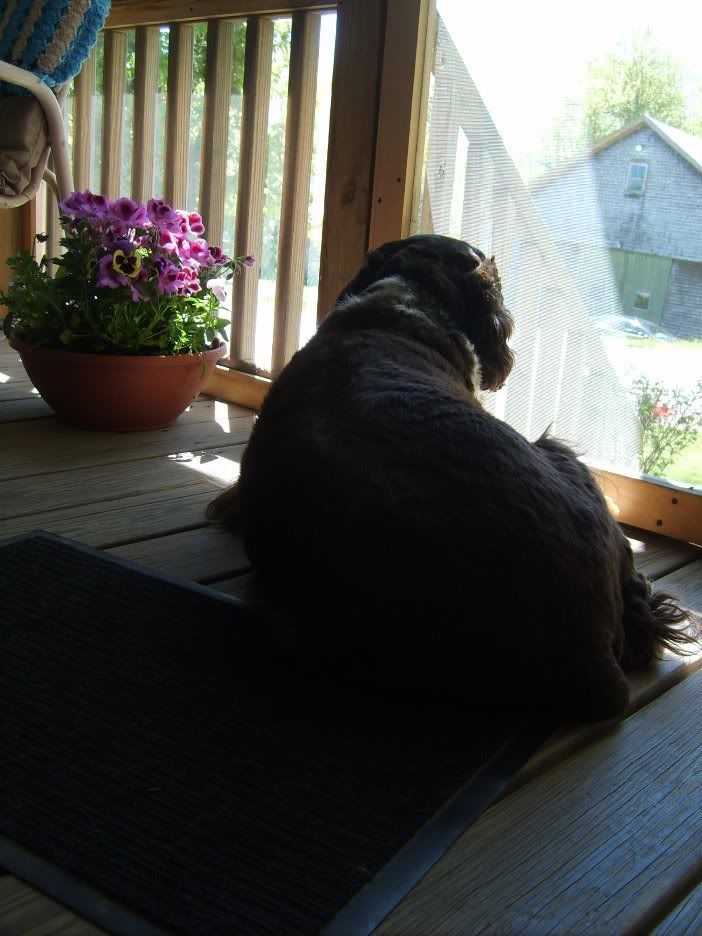One afternoon, my husband and I were cleaning the house with a high-pressure hose and along the way battering the top of a plastic watering can.
“This hose is cleaning the house,” he said, “but it won’t budge this.”
In the mouth of our watering can were strands of a cobweb that would not break even under the force of the water. The silk is so tough it can last for years if undisturbed, which is why cobwebs seem to appear wherever you look. In fact, there are all kinds of spider webs practically everywhere. Our deck on summer mornings looks like a construction site, with guy wires strung from house to chair to geranium plant.

These wires are the initial bridges of the familiar spiral-shaped orb webs. To set one up, the orb-weaving spider trails a strand of silk from a prominent spot like a grass tip or a deck chair, and the breeze catches it and tacks it serendipitously to another blade of grass or corner of the house. The spider then walks this bridge back and forth paying out silk to reinforce it. When the bridge feels sturdy and taut, the spider ties another line to it and drops down to secure it below. Next, in a methodical, craftsmanlike process, the spider builds radial spokes and two sets of spirals – one temporary scaffolding, then one permanent — until the day’s web is complete and ready to snare flying meals. A black and yellow garden spider takes a half-hour to an hour to complete the engineering of an orb web 1 to 2 feet in diameter.
I’ve never seen the whole building process from start to finish, but I watched an Araneus diademetus spider ride an orb web fastened between the outside mirror and the door of my car unharmed through 55 mph wind all the way to my house one evening. When we stopped in the dusk light in the garage, the spider fussed with some threads for a minute or two, and then in less than five seconds dismantled the whole thing and retreated under the mirror for the night.

Orb weavers are programmed by instinct — whatever that is — to construct orb webs, while other spiders make cobwebs, sheet webs or funnel webs, which you can see on the lawn covered with dew in the morning. They’re a few inches or a foot wide, and have a funnel in the center where the grass spider, for example, waits for insects to get tangled up, then darts out to capture them. There also are minimalist “reduced webs” that may be only an H shape or even just a single strand.
The silk of an orb-weaving garden spider is about .00012 inch in diameter; at this size, it’s stronger than steel and more difficult to break than rubber. Spider silk can stretch up to 15 percent of its length before it breaks, and in some cases more. This toughness has been compared to Kevlar, which is used in bullet-proof vests and stretches to about 4 percent before breaking. The strongest natural fiber known is the silk of Nephila genus spiders in the South Seas, which islanders make fish nets out of.
You’d think a fiber like this would be manufacturable, but so far no one has been able to figure out how to farm it. To produce the silk in sufficient quantity, you need a lot of spiders, but it turns out you can’t keep too many spiders together in one place because they eat each other.
Spiders’ silk, which is a protein, is produced by glands in their bodies and dispensed through spigots mounted on spinnerets on their abdomens. They spin tiny threads together into single strands, and can generate seven different kinds of silk for different purposes, including insect traps, as well as shelters, egg cases, and nests for mating and in some species nursing their young. Some spiderlings throw out a line of silk from a high place, let the wind take it like a sail, and go “ballooning” off to seek their fortunes in parts unknown. Great clouds of voyaging spiderlings have been reported miles out to sea.
I’ve watched garden spiders carefully making repairs to webs, working the claws at the tips of their legs as dexterously as if they were sewing or knitting. It seems there must be some consciousness of what’s happening in an operation that intricate — the spider clearly makes judgments about strength, tautness, elasticity and shape. Some orb-weaving spiders are more attentive to symmetry and perfection when young, then get a little sloppier as they age. Are spiders aware of what’s functionally necessary and of what’s decorative, or beyond?
How you would ever know the answer to this question, I’m not sure. What spiders think of their silkwork, I do not know, though I’d like to. At least, it’s my instinct to wonder, and I’ve left those cobwebs practically everywhere in one form or another.
Here is one of the stories of Grandmother Spider:

When the Universe was still so dark that not even shadows could be seen in the night, Grandmother Spider sat in her web in the Sky World, waiting and watching. No one knows how old Grandmother Spider is, or how long she sat waiting for the Universal Mind to awaken. But, every Creature Being who has ever lived knows her song and dance as the weaver of the Web of Life.
From her web, Grandmother Spider observed the first thoughts as the Universal Mind awakened from the dream. Seven energy beings floated out from the shining light in the center of the Universal Mind and solidified into bright, shining stars who went out to take their places in the Sky World. Grandmother Spider took a very deep breath and softly began to sing her weaving song while she danced across the Sky. As she spun her thread, Grandmother Spider envisioned the Web of Life. Within moments, she had woven her web connecting the seven stars and creating the Spirit Doorway through which all of the rest of life would enter.Art by Lyndia Radice
The seven stars reflected the spectrum of all colors within their glow. Dancing with the colored light, shadows came into being as the darkness took form. More thoughts flowed from the Universal Mind, entered through the Doorway of the Seven Stars, and took their places in the Sky World. These became more stars, suns and planets. Then, many other thoughts entered the Universe, each one taking a specific place according to the universal dream of harmony.
Each thought was a spirit essence who dreamed an individual dream for manifesting life. Grandmother Spider spun her web around each new energy being and the Universal Web of Life shimmered in the reflection of Great Mystery's light.
Singing her song and weaving the Web of Life, Grandmother Spider continued with her work. The Sky World filled with light and life as her creative process unfolded. As the stars, suns and planets prepared to give birth to their children, Grandmother Spider spun her cord even longer, so that all of the newly born could be included in the Web of Life. Grandmother Spider continues to weave the Web of Life throughout every cycle of creation.
All life everywhere in the Universe is connected by the Web of Life. We are not separate beings. We are each a part of the Great Mystery, manifesting as an individual awareness in a separate physical body, but sharing the same energy as all other life. The energy web is anchored within our center and is our connection to the Great Mystery.
Along with Grandmother Spider's web cord, we carry within our center our dream for living that includes a promise and a purpose. Before we came into the Earthwalk, we chose the gifts and talents that help us create the reality that we envisioned. We also chose the lessons and challenges that motivate our learning and growth.
Our dream for living carries a specific vibration of sound and color that guides our spirit essence in it's flight from the Universal Mind, through the Sacred Cave, and into the womb of our physical mother. During our Earthwalk, we live our choices and lessons, and develop our talents and gifts, as we meet each situation and challenge of our growth. We must remember our purpose and promise and focus our life in this direction if we are to be happy and fulfilled.
Grandmother Spider weaves the Web of Life around us when our spirit essence enters its physical body inside the womb of our mother. From feet to head, our spirit essence is woven together with our physical body as Grandmother Spider sings her weaving song to us.
When she completes her weaving, Grandmother Spider does not cut the cord, but leaves an energy trail with her weft thread that goes out from our center to connect with the next Creature Being that will enter the Web of Life.
The gift of Grandmother Spider is the personal energy web that we walk with throughout our entire life. This energy web allows our spirit essence to experience our senses, emotional feelings and physical pain and pleasures. This connection also allows our physical body to develop an intuitive perception of Universal Wisdom. Through the web, we can work with energy for creativity and healing. Our personal energy web maintains our connection to the Web of Life and the Great Mystery. This gift of Grandmother Spider insures that we are never alone, for through it we always share the love of All Our Relations.
Our energy web surrounds our physical body, enveloping it with a vibrating energy that is our personal rhythm. Our energy web is connected to our physical body through energy centers that are the communication channels between our physical body and spirit essence. Our mind is the link between body and spirit essence, interpreting and directing the flow of energy back and fourth. Breathing and movement enables our body to direct energy and our thoughts to affect our physical health. To live in comfort, we need to maintain a balance of body, mind and spirit within our personal energy web.
Grandmother Spider is always busy with her work, as the creation of life is happening at every moment. After connecting each Creature Being within her vibrating threads, Grandmother Spider goes on to the next, spinning out a continuous cord in her never ending dance. A Creature Being enters the Earthwalk, then a Plant Person, a Stone Person, a Water Person, a Four-Legged, a Two-Legged, and on and on. For each of these, Grandmother Spider weaves a personal energy web and extends her cord out from this Creature's center to continue on with the weaving of the Web of Life.

The Web of Life is a beautiful braid that holds the energy of all life together. Grandmother Spider's dance of spinning and weaving continues indefinitely, as new patterns within the web are being woven every moment when each new life enters the Earthwalk.
At the other end of Grandmother Spider's tapestry, the web is always unraveling, as every spirit essence travels back through the doorway of the Sacred Cave to the Spirit World when life is complete.
All life shares an equal place within the Web of Life. The gifts and contributions of each and every Creature Being are very important for the survival of MotherEarth. Each Creature Being, in following through with the performance of their specific life task, affects the welfare of all the other Creature Beings in the web. Without the benefit of even one Creature's work, the Web of Life would lack the energy of wholeness necessary for the circle of life's cycles to continue on with their rhythm.
















![Anafalis perłowy (Anaphalis margaritacea) / Warszawa; Ogród Botaniczny Uniwersytetu Warszawskiego [lipiec 2006] Pictures, Images and Photos](http://i36.photobucket.com/albums/e13/Skomor/Rosliny%20i%20im%20podobne/Okrytonasienne/Dwuliscienne/Anafalis_perlowy.jpg)













































